Note: check out my update below to see what the transplant and divisions look like after one year!
We finally bit the bullet and decided have our lower deck replaced. The fat deposit check went out in the mail last week, so it’s getting real. We should have pulled the plug 3 years ago before the wood began to disintegrate, but oh well. Walking around on a rotted deck has kept us nimble and improved our powers of observation.
The work hasn’t been scheduled, but it will happen sometime before fall, which means moving the surrounding plants almost midsummer. I planted everything so close to the deck that there would inevitably be serious plant damage during construction. They’d also be in the workers’ way, so it would be a little rude not to move them.
Anyhow, two plants I really wanted to salvage from this spot are a Slender Hinoki Cypress, which I’ll talk about in a future post, and a June Hosta I planted 7 years ago. As it turns out, the spot I decided to put the Cypress was home to a Sum and Substance Hosta , so I had to move that one as well. Two-for-one bonus!
The Transplanting Process
This is not the ideal time of year to transplant hostas, but I’ve done it before and have yet to lose one. The lovely Seattle climate and general hardiness of hostas contribute to that success, but there are some key factors that help:
- Prep the soil. Dig a large hole transplant hole and amend the soil with a healthy dose of compost. No fertilizer! Think bland hospital food after surgery.
- Keep air off the roots. After transplanting and backfilling, compact the soil enough to eliminate air pockets.
- Water, water, water. Because the hosta has all its leaves, it will be thirsty. Normally hostas are drought tolerant but they’ll need extra moisture when transplanted fully leafed out.
Lastly, and the most fun – use twine to tie up your hosta leaves! This gets them out of your way before you dig, and creates a more compact bundle which is easier to handle.
Enough with the words, here are some pictures (and more words):
Extracting the Hosta
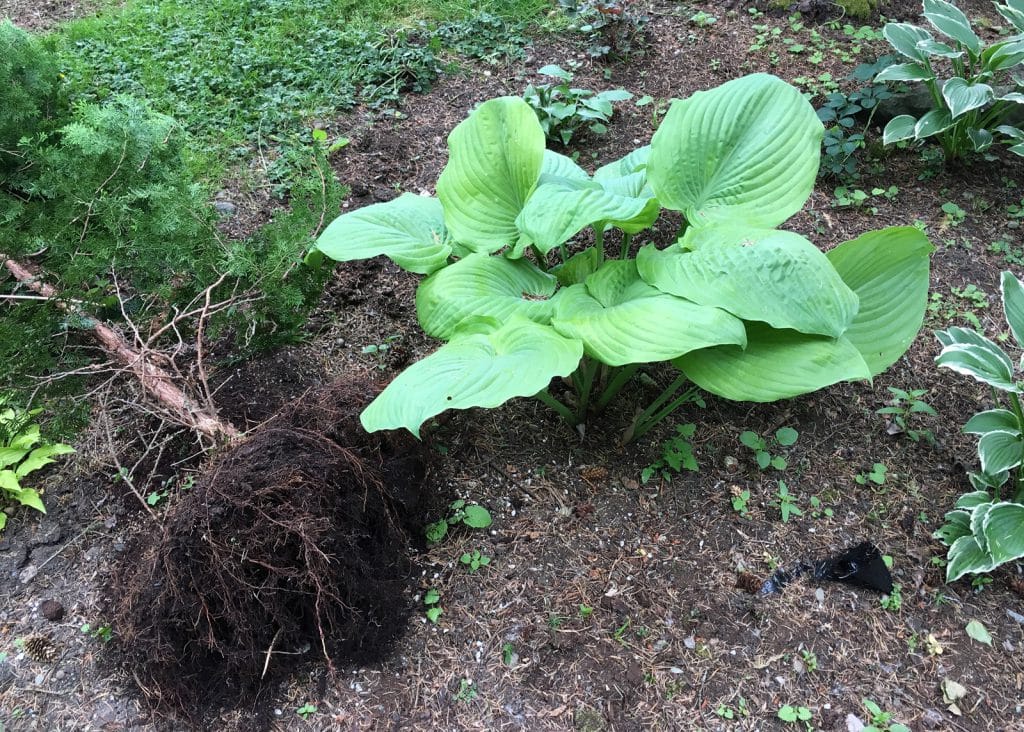
I want the Hinoki Cypress to go where the hosta lives, so the hosta needs a new home. This is a Sum and Substance hosta about 6 years old. I think I’ve moved it at least twice already, which might be why it’s still smallish. Also note the friendly weeks popping up to join the party. Another item for the to-do list…

Tie it up! I used a natural fiber twine. It’s thick enough that it won’t cut through the leaves, and light enough to be easy to work. The rough surface also has some grip, so it won’t slide down. Kinda like a good pair of skinny jeans…
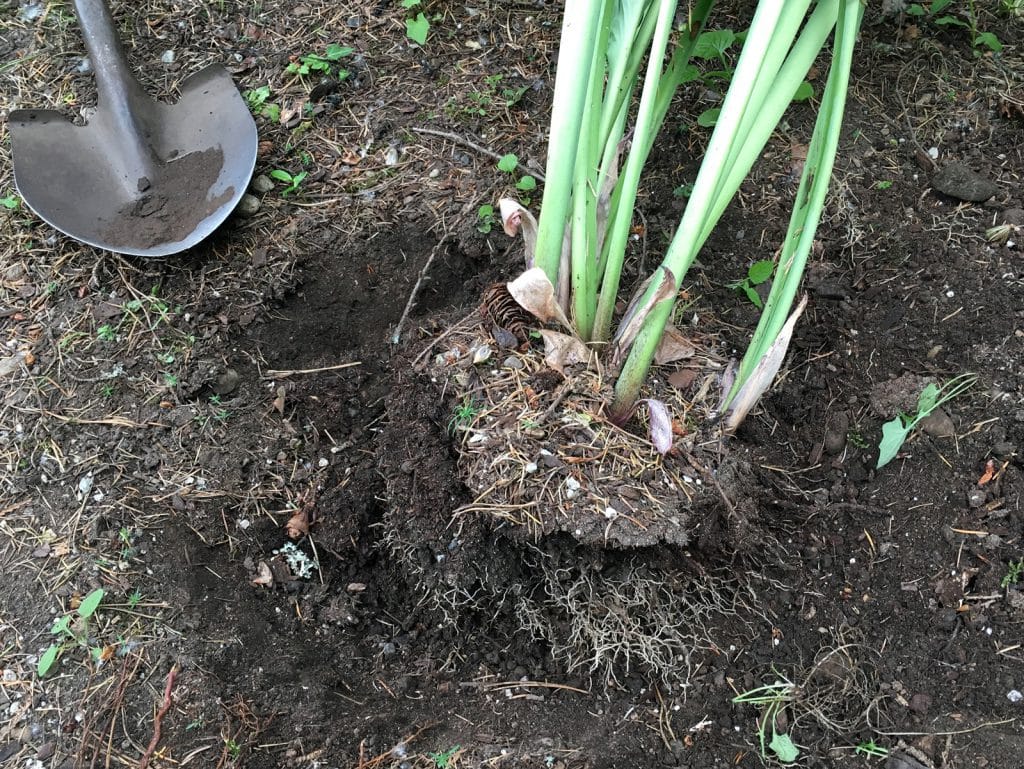
Dig around the roots. A good margin will have some smaller roots showing around the edge. Try not to cut through the larger roots near the core.
Prepping the New Home

Dig a new hole roughly 50% larger than the root ball. Add a layer of compost to the bottom. The overall amount of compost you add depends on how crappy your soil is. Ours is moderately crappy in this area so maybe 30% to 50% of the backfilled soil is compost.
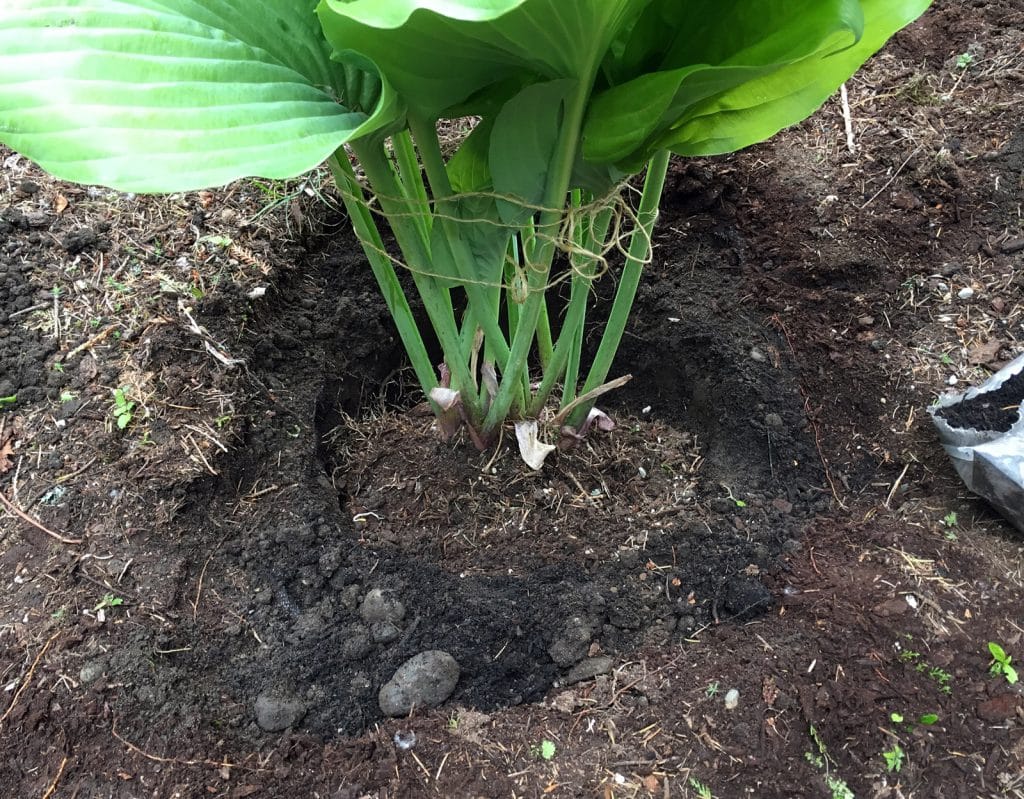
Place the hosta in its new home. This ground is sloped so the photo looks a bit weird – the hosta is upright, I promise.
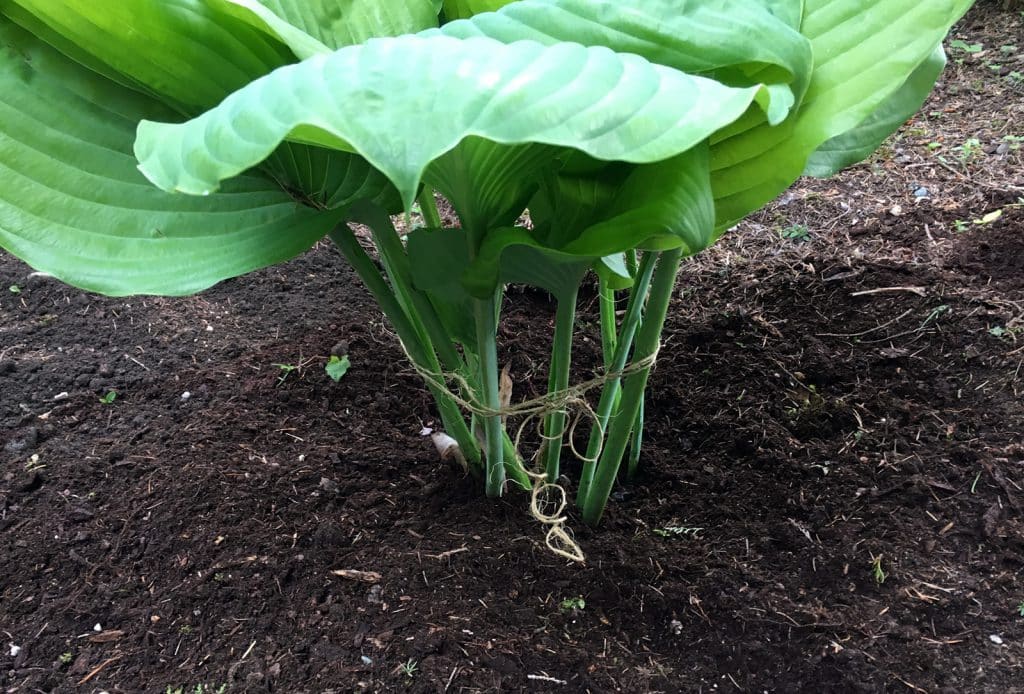
Backfill with an even mixture of compost and native soil. I’ve found that hostas aren’t too picky about their root crown being buried, Having said that, I try to make a dirt “bowl” around the plant with the lowest point of the bowl at level with the leaf bases. Does that make sense? This is why I’m not a technical writer…
The bowl acts as a retention pond so water doesn’t immediately run down the slope instead of into the soil. Also, compact the soil! I tamp the area down with my foot which probably looks pretty funny. Good thing only the birds can see me in this area of the yard.

Untie the hosta! Using a slipknot makes it easy. Using gloves makes your hand less filthy than mine.
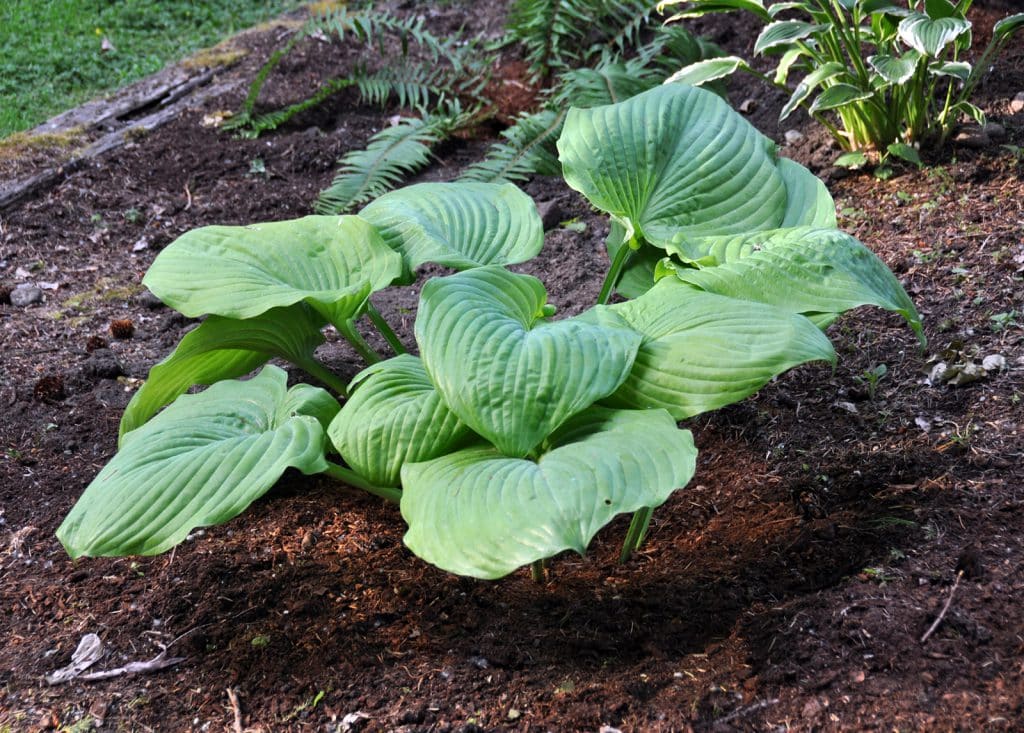
This a photo of our patient the next day. I’ve added a layer of mulch to help retain moisture. It looks pretty happy!
Same Process Plus Division – a June Hosta
Just when you thought this post couldn’t get any longer…
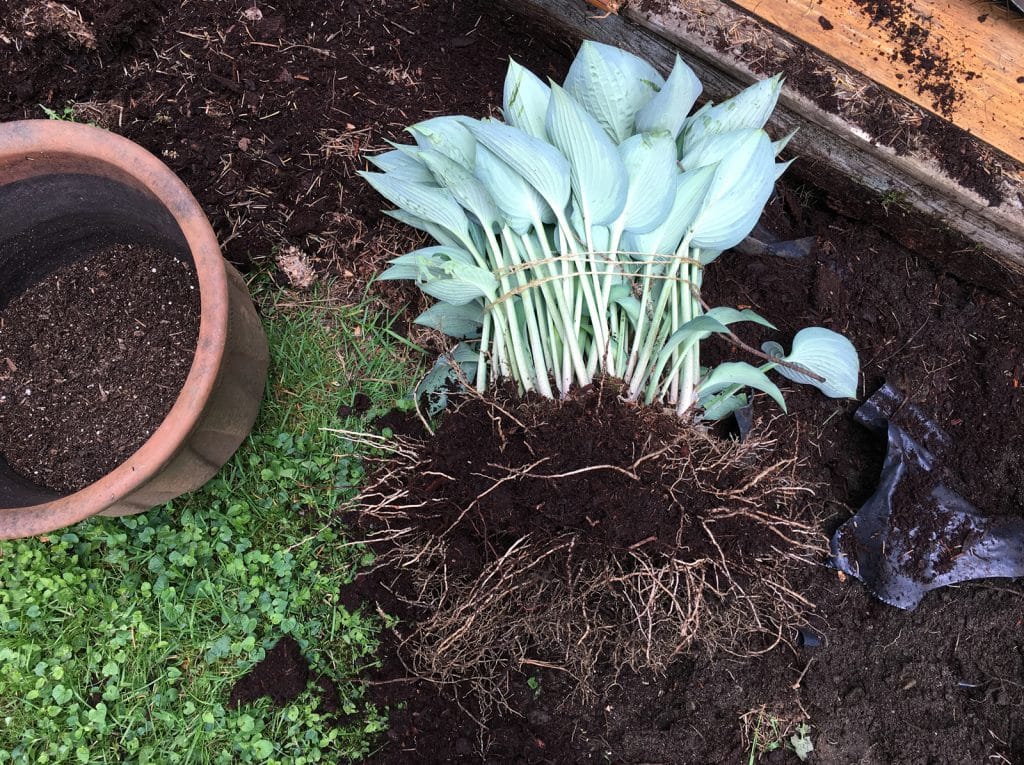
Back at the deck, I’ve already tied and dug up the June Hosta. I’m going to split this guy in half, planting one part in the pot you see here, the other in the yard near the Sum and Substance I just moved.

Split! This one was tough. I used a combination of 3 things: A shovel (that could be sharper), a handsaw (reserved for gardening since the grit will make it unusable for woodworking), and brute force strength to pull it apart (rawr). I’ve seen other tutorials recommend washing away the soil and gently prying apart the roots instead. I find that unnecessary. This is way faster and a lot more fun.
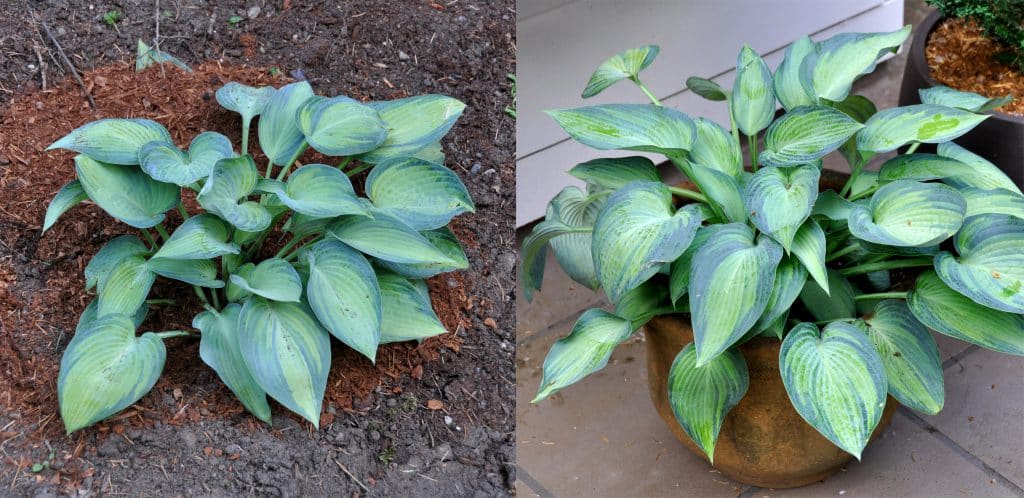
Replanted divisions. One in the ground, the other in a pot. This is a pretty mature specimen, which is a great candidate for dividing. I probably could have split this 3 ways, but I decided I had enough work to do that day.
You might have noticed the leaves look a little banged up. There’s a waxy substance on blue hostas that comes off easily when the leaves are jostled. It’s an unavoidable side effect when transplanting leafed-out blues, especially if you are madly sawing the root ball apart. If you have suggestions about how to minimize this, I’d love to hear it!
I hope this was helpful. If you have suggestions for how to improve this process, let me know in the comments!
UPDATE: One Year Later
I love before and afters, so here’s an after! These are some pics of the transplant and divisions one year and one month after the time I originally posted this story. They are doing quite well, and are sporting some flowers since we’re a little later in the season.
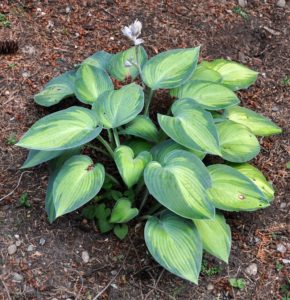
The other division went down into the back yard pretty close to the Sum and Substance transplant. It’s a dry area so it’s looking a little less vigorous than the pot division. Still lovely but a little more slug-eaten and sunburned on the lower leaves.
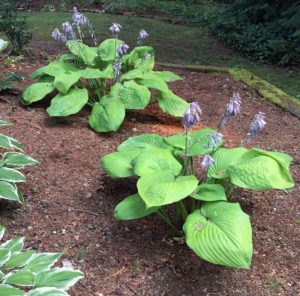
The Sum and Substance I transplanted is in the foreground – you can see that compared to the non-transplanted specimen in the background, it has fewer leaves. So the transplanting may have set back its growth a year, but still looks pretty great IMO.
[icegram campaigns=”2215″]


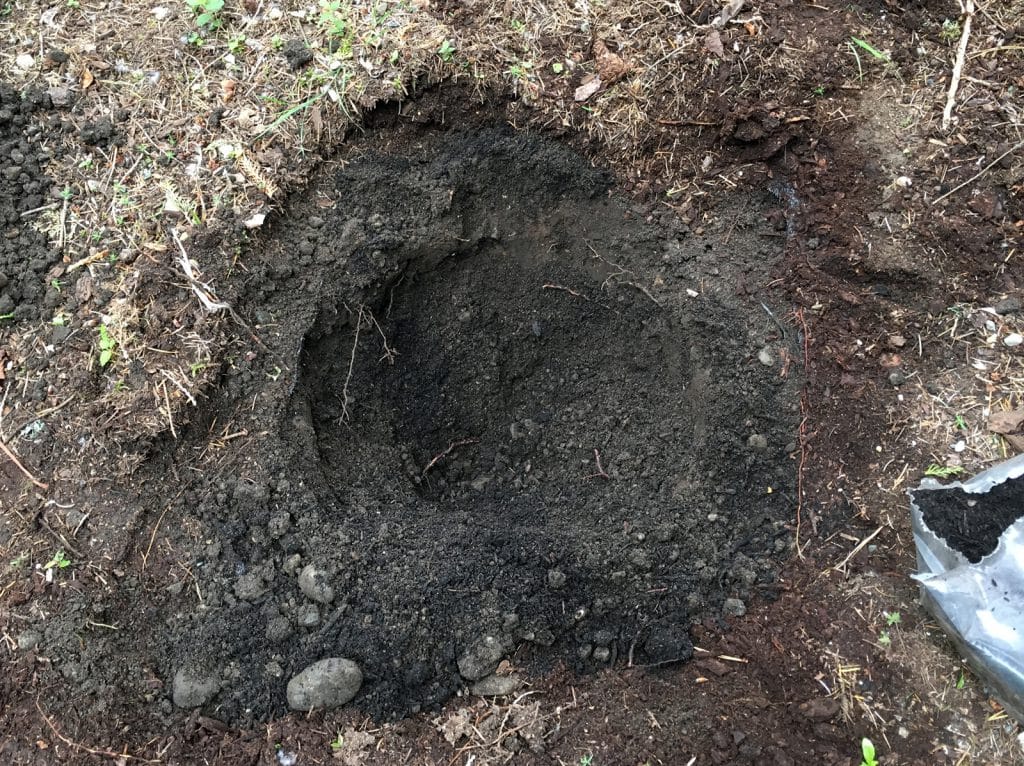



Thanks so much for the tips! I had a similar situation and wasn’t sure of the best approach. Your method saved the day for a very large Earth Angel hosta. And the leaves are no worse for the wear, so a technique worth remembering.
Thanks again!
Karen
Hi Karen, thanks for your comment, and you’re welcome! I just looked up the Earth Angel hosta and it’s a beauty, I’d definitely be propagating mine if I had one!
Thank you for the post I got Hosta’s Galore at the house I bought and need to move them for my Garden. I don’t have much shade since the Trees were cut done, think I can pot them and provide shade with a tarp off the fence line?
Hi Renee! Thanks for your question – I think as long as the hostas are getting shade and adequate water they should do ok. My only concern would be depending on your setup, the tarp could create a greenhouse effect, heating up the area underneath it – which could stress the plants. If there is adequate airflow it should be fine. Good luck!
I transplanted 8 hostas yesterday. They are not standing up. Like they are still wilted
What can I do to help them? Can anyone help me?
Hi Mary, this sounds transplant shock. I’d make sure and water them deeply, every day for the next week or so. They usually stand back up. It’s possible that too many of the roots were cut during transplanting – if that’s the case they may not recover this year, but should come up again next year (maybe a bit smaller!)
I use my grandmothers “butcher’s “ knife to split hostas and day lilies
Fast and efficient
Nice! Sounds like a great tool for that. Thanks for sharing!
Wow, so glad that I found your advice about moving hostas! We also are rebuilding an old deck and had to move several gigantic, mature hostas that we have no idea when they were planted. We have them surviving for 2 days but, since some sections of the divided hostas have very long stems, they don’t seem to be able to stand up. I water daily, several minutes at each plant. The smallest leaves are fine. Any suggestion about what to do with these long stem reclining leaves?
Hi Joy, I’m glad you were able to move your hostas! They may be wilting a bit from transplant shock which is normal. The leaves could perk back up after a while, but I have had transplanted hostas that looked a bit floppy for the rest of the season. If this happens, you could cut a long strip of burlap (or other ribbon-like piece of fabric) and wrap it around the stems like belt to help cinch the leaves into a tidier bunch. As long as the plants get regular water they should come back as big and beautiful as ever next year. Hope that helps!
We have decided to enclose our screened in porch. It is July 4th and the contractor is starting next week. We have to move at least 14 mature hostas (many different varieties). What to do until the construction is done? Maybe 4- weeks. We are building a ground level deck, too. I am thinking I can put them in pots until construction is done. Is that a good idea? Thanks! Rebecca
Hi Rebecca, I would definitely put them in pots with some extra soil and keep them well watered in a shady spot. They’ll probably look a little rough for the rest of the year, but after you put them back in the ground they should spring back next year just fine!
My hostas lost their shade tree and I’ve been using beach umbrellas to compensate
After finding your post I now feel more confident to move them.
Thank you!!
You’re very welcome, have fun transplanting!
Just looking up this advice here in September 2020. I have a huge hosta (don’t know the variety) that I picked out as a replacement and it is just too big for my spot which I believe is also a little too sunny. Should I wait til spring to relocate it?
Also, thinking about using some containers next season. What do I do with them during the winter? Bring them inside?
Hi Barb! You can relocate hostas in spring, but I would simply wait until the leaves have almost died back this fall and transplant it then. Fall is a great time to do it. That way you’re not damaging any of the pretty new spring growth next year. Unless you are in USDA Zone 4 or colder, I recommend leaving the containers outside for winter. Hope that helps!
I transplanted my split hostas but I cut off the leaves will this hurt them? I did leave quite a stem.
Hi Susan, I think they will be fine with a few missing leaves. In fact it might be a good thing because now the roots will have less foliage to support, so the remaining leaves may better survive the summer heat. Thanks for your question!
Hi,
I have been trying to grow hostas in a pretty shady area and know it is not the right spot. Every year it comes up but either bugs get to it or once it got run over by the lawn mower. This year I was really happy to see it growing it was about a foot tall and then the bunnies (we have in Seattle tons of wild bunnies) got it. Should I transplant now in July into a pot with chewed up leaves or should I wait for a better time? I also have Hostas in big pots by the front door that are not being disturbed so thought I would go that route.
Thanks for any help
Michele
Hi Michele! Those bunnies are cute but they sure are pesky! I nearly lost a hosta to their nibbling early this spring. I would dig up that hosta and put it in a pot if I were you. I think it may survive better in a pot – as long as it’s well-watered through summer. If the bunnies and other pests continue to consume the leaves, the plant won’t be able to gather the energy needed to survive and thrive into next year. Good luck!
Hi Lorie, when splitting the large bulb in half, try using a Sawzall with a 9 inch wood blade. It will be quick and clean with minimal if any damage to the plant. I recently took out some low level evergreens using a Sawzall and it worked perfectly. Tha blade got right down in the dirt an cut the root out pretty far below ground level. It turned out great. Good luck,I’m about to do the same with donor hosta’s from my neighbor. Thank you for the article .
I use two 4-tined garden forks…press them firmly back-to-back into the root clump and pry them apart! Works great, with very little root damage
Hi Susan, that is a great idea! Thanks for sharing your division method!